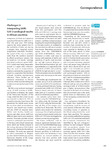Challenges in interpreting SARS-CoV-2 serological results in African countries
Ndaye, Antoine Nkuba
Hoxha, Ana
Madinga, Joule
Marien, Joachim
Peeters, Martine
Leendertz, Fabian H.
Mundeke, Steve Ahuka
Arien, Kevin K.
Tanfumu, Jean-Jaques Muyembe
Kingebeni, Placide Mbala
Vanlerberghe, Veerle
A diagnosis of COVID-19 is based on a positive PCR test for SARS-CoV-2. Over the past year, PCR testing capacity has varied globally due to the availability of tests, and testing strategies have targeted mainly symptomatic individuals. Therefore, the spread of the virus is probably wider than the numbers reported by official surveillance systems that are based on PCR results. Serology tests detect antibodies against SARS-CoV-2, which start being measurable around 1–2 weeks after infection. They are used in seroprevalence studies to estimate the proportion of people in a population that has been infected, including asymptomatic infection. These studies are of particular importance in African countries, where reported testing and incidence are among the lowest in the world.
Dateien zu dieser Publikation

